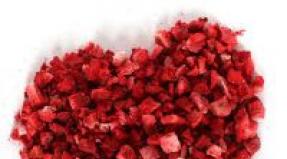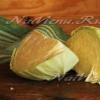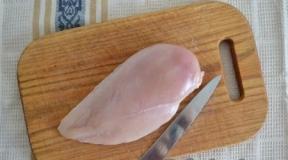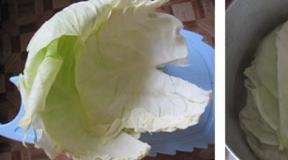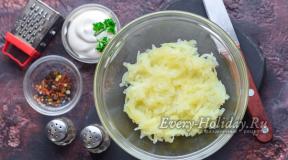How to cook horseradish for the winter. Traditional recipe for harvesting: "White horseradish"
Many people know how to cook "horseradish" for the winter. After all, this is a traditional Russian sauce, the main components of which are fresh meaty tomatoes and horseradish. If you do not know how to stock up on such a blank, then we will tell you about it.
Main product properties
Before telling you how to cook "horseradish" for the winter, you should tell you what properties this sauce has.
This preparation is quite spicy. Horseradish gives it such taste. Moreover, thanks to this vegetable, "horseradish" becomes not only spicy, but also useful. It has high antimicrobial properties, improves immunity well, as well as the body's resistance to various diseases. However, it should be noted that due to the rather strong spiciness, this sauce is not recommended to be consumed in large quantities by those who have problems with the gastrointestinal tract. If you neglect this advice, you can easily get aggravated.
Classic "horseradish": a recipe for the winter of tomatoes and horseradish root
To make a classic "horseradish" at home, you should use only ripe and fleshy tomatoes. This will give the sauce a special thickness and soften the harshness of the horseradish.
So, before you make "crap", you should purchase:
- large horseradish root - about 100 g;
- salt is not very large - about 1.5 dessert spoons;
- tomatoes as ripe as possible, fleshy - 1 kg;
- granulated sugar - a full small spoon;
Preparation of ingredients
How is the classic "horseradish" prepared? The recipe for the winter involves the use of only fresh vegetables. They need to be washed and dried well. At the same time, it is recommended to clean the tomatoes from the navels, and horseradish - from the peel.
The process of making spicy sauce
Before you prepare horseradish for the winter, you should take a few glass jars (750 g) and sterilize them together with screw caps in any way you know. Next, you need to chop the tomatoes in a meat grinder and send the horseradish root with garlic there.

After you have formed a fragrant gruel, add sugar and salt to it, and then mix thoroughly. Having received a homogeneous mass, it must be distributed among sterilized jars and tightly twisted. You can store such a blank all winter, but only in a cool room. If you place a jar of hot sauce in a warm place, it will begin to ferment very soon, and then completely go out of the container.
How to cook "horseradish" from tomatoes and vegetable oil?
This method of cooking homemade "horseradish" was invented after a sad experience when the housewives' sauce turned sour or moldy. To avoid such situations, this workpiece began to be made using odorless vegetable oil.
So, we will need:
- horseradish root as fresh as possible - about 200 g;
- salt is not very large - 1 large spoon;
- tomatoes as ripe as possible, fleshy - 2 kg;
- granulated sugar - a full large spoon;
- vegetable oil - ½ cup;
- large fresh garlic - about 200 g
Cooking method
The classic homemade "horseradish" does not require heat treatment. But if you want to get a softer sauce that will be stored in the cellar for a long time, then it is still recommended to cook the tomato base on the stove.

So, to prepare "horseradish" you should wash fresh tomatoes well, and then peel them by scalding them with boiling water. Next, the vegetables must be chopped in a blender or meat grinder. After that, they need to be placed in an enamel basin, bring to a boil and cook for about 15 minutes. After this time, salt, vinegar, sugar and vegetable oil should be added to the tomato mass.
While the tomatoes are simmering over low heat, you need to start processing the remaining components. To do this, you need to wash the horseradish root well and grind it in a meat grinder along with garlic cloves. Next, the spicy mass must be added to the boiling tomatoes, mix everything thoroughly and immediately remove from the stove.
Formation process
Now you know how to cook "horseradish" from tomatoes and sunflower oil. But in order for such a sauce to be stored in a cold room for a long time, it should be properly rolled up. To do this, you need to take a few liter jars and sterilize them with steam lids. Next, each container needs to be filled with hot "horseradish" and immediately rolled up. After turning the jars over, they should be covered with a thick cloth and wait until they cool completely. At the end, the spicy Russian sauce must be removed to the pantry, cellar, refrigerator or cellar, where it can be stored for about six months.

Cooking "horseradish" with beets
If you are fed up with the classic Horseradish appetizer, then you can change it a little. For example, add beets. With such a vegetable, the sauce will become not only richer and more tasty, but also quite bright.
So, we need:
- horseradish root - about 150 g;
- salt is not very large - 2 dessert spoons;
- tomatoes as ripe as possible, fleshy - ½ kg;
- granulated sugar - 2 large spoons;
- table vinegar - 3 large spoons;
- vegetable oil - 3 large spoons;
- large beets - 800 g;
- ground pepper - a pinch;
- large fresh garlic - about 100 g
Cooking process

Before you cook "horseradish" for the winter, you should wash the beets well, and then boil them, cool them, peel them and chop them very finely. Next, you need to rinse the tomatoes and horseradish root. It is advisable to grind these ingredients together with garlic cloves in a meat grinder.
After processing all the components, they must be put in an enameled container, seasoned with salt, sugar, pepper, vinegar and vegetable oil, and then heated over low heat, but not brought to a boil. Next, the hot sauce needs to be decomposed into sterilized jars and rolled up well. After keeping the beet horseradish at room temperature for a day, it should be removed in a cold place. In such conditions, the sauce can be stored for about 5-7 months.
"Hrenovina" with the addition of ripe plums
We talked about how the beetroot "horseradish" is prepared (the photo is presented above). However, there is another, no less original, way of preparing such a sauce. It consists in the fact that ripe plums are added to the main ingredients. It should be noted that this sauce has a rather unusual and piquant taste - with a slight sourness and a characteristic fruit aroma.
So, to prepare such a horseradish we need:

How to cook?
To make "horseradish" with plums, the fruit must be washed well and pitted. It is also necessary to rinse the horseradish root and tomatoes. After that, all components should be chopped in a meat grinder (including garlic). Next, they must be mixed well and poured with boiling water. While the base is warm, not very coarse salt, sugar, bite and vegetable oil should be added to it. Finally, mix all the ingredients with a large spoon and set aside to cool.
Container preparation and seaming
While the finished sauce is at room temperature, you should proceed to sterilize the jars. To do this, add half a glass of water to the container, put it in the microwave and turn it on at maximum power. After 5 minutes, the cans can be safely removed. As for the lids, it is recommended to place them in a bowl, add water and boil over high heat for 10 minutes.
After all the steps have been carried out, it is required to pour the plum "horseradish" into sterilized containers and immediately roll it up. After a day, the blanks can be removed to any cool room where the rays of the sun do not fall. It is recommended to store such "horseradish" for about 2-3 months.

How to use?
Now you know how you can cook your own classic "horseradish" with beets, butter and plums. Which of the above methods to use to create a fragrant snack is your own business. In any case, such a sauce turns out to be very tasty, fragrant and spicy. It is recommended to serve it to the table along with dumplings, manti and other second and first courses. It can also be used to make sandwiches. But for this, it is advisable to make the "crap" a little thicker so that it does not drain from the bread.
Horseradish or horseradish- a spicy sauce made from horseradish, ripe tomatoes and garlic, without heat treatment. Siberia and the Urals are considered its homeland, from where it spread to other territories. In addition to these names, you can also find others - horseradish snack, cobra, Siberian light, gorloder. To your taste, it can be compared with, only more spicy and burning. This sauce will be an excellent addition to dishes of meat and fish, pasta, vegetables. In addition, it is also used to prevent influenza, acute respiratory infections, viral diseases, to increase immunity. Because horseradish tomato very sharp and burning, then with caution it should be used by people with diseases of the digestive system.
Some recipes recommend adding a crushed aspirin tablet, due to the fact that the sauce does not undergo heat treatment and in order to better preserve it. Adding aspirin to horseradish, as well as to other types of preservation, is strictly prohibited. , which is part of the sauce, already has antiseptic properties, and together with salt and sour tomatoes, under conditions of proper storage and preparation, you can not be afraid of souring horseradish. I would also like to note that the more garlic and horseradish you put in it, the longer it will last.
Ingredients for tomato horseradish for the winter:
- Horseradish root - 300-400 gr.,
- Tomatoes - 1 kg.,
- Garlic - 1 head,
- Salt - 1 tablespoon,
- Sugar - 1 tablespoon.
Tomato Horseradish - Recipe
So, to cook horseradish, you need to cook ripe fleshy tomatoes, garlic and horseradish roots. You will also need some salt and spices. Wash the tomatoes thoroughly, tear off the stalks. It is advisable to use ripe and undamaged tomatoes, without spoiled areas. Next, cut them into 2-4 parts, so that later it would be easier to scroll them in a meat grinder. Pass them along with the skin through a meat grinder.
Rinse horseradish roots with water. Using a sharp knife, remove the rough skin from them. After that, cut into several pieces and pass through a meat grinder. Be sure to tie the neck of the meat grinder tightly with a plastic bag, this will allow the essential oils not to spread around the apartment and save you from tears. If you have a blender, then you can use it. Remove the bag of ground horseradish, tie it up and set aside.

Peel the garlic cloves. Adjust the amount of garlic to your liking. If you want to make a hotter sauce, feel free to add more of it. Garlic, like horseradish with tomatoes, also needs to be passed through a meat grinder. Add the horseradish to the bowl with the tomato puree. Put out the garlic.

For extra flavor, I also add spices. To make it even more vigorous, you can add a pinch of red ground pepper or finely chopped chili pepper.

Add kitchen salt. If your tomatoes are sour, then you can sweeten the sauce a little with sugar. For one liter of horseradish add 1 teaspoon of sugar.

Mix all the ingredients, be sure to taste it. After making sure that all the components are enough, put them in sterilized half-liter jars. Close jars with metal or screw caps. In addition, nylon steaming caps can also be used. Since this sauce was not amenable to heat treatment, it is advisable to store the jars in a cold room.

Horseradish from tomatoes. Photo

It will not be difficult to prepare an incredibly tasty and interesting snack for any feast if you know some secrets. At the same time, the most common products are used. The taste is phenomenal and rich. Horseradish connoisseurs will understand what we are talking about as soon as they feel this intoxicating taste and aroma.
There are many recipes with various components that enhance and emphasize this dish. Everyone prefers their own recipe. Some prefer classic options, while others will like experiments. The result is always an unsurpassed appetizer that can please all lovers of spicy.
How to cook horseradish with tomatoes and long-term storage garlic
The secret of the proposed recipe is the freshness of the products used. No brewing or sterilization is needed. Just a natural rich taste, stored for a long time, without additional tricks.

Ingredients:
- Tomatoes - a couple of kilograms.
- Garlic - 150 grams.
- Horseradish root - 350 grams.
- Salt - 15 grams.
- Sugar - 10 grams.
Output: 2 liters.
Cooking process:
1. Thoroughly rinse the tomatoes. Remove all unnecessary. To cut in half. Cut out the stem.

2. Peel the garlic cloves. Remove the skin from the horseradish root.

3. Cut the root into small pieces. Place in a blender. Thoroughly grind until a homogeneous mass is obtained.

4. Place garlic cloves in a meat grinder and process well.

5. Finely chopped tomatoes also pass through a meat grinder. Do not forget to drain the formed juice into the prepared container.

6. Place all products in a saucepan and mix.

7. Add salt and sugar. Distribute the resulting sauce into pre-prepared jars. Close tightly with lids. Place in refrigerator.

8. Horseradish can be consumed immediately. It will acquire more taste in 3-5 days.
Also watch our video recipe:
Until January, you can provide yourself with a tasty and healthy snack that can diversify any feast and add more flavors to it.
Horseradish with beets
Why resort to store preparations when you can prepare everything in advance yourself? From this, the taste of the dish will only benefit, and the result will exceed any expectations. Horseradish, with fresh beets, will be a worthy sauce for any meat dish. It will not only shade any products, but also give them a special piquancy and richness.

Ingredients:
- Svela - one medium root crop.
- Horseradish root - 350 grams.
- Table vinegar - 10 milligrams.
- Filtered water - 1/2 cup.
- Salt - 10 grams.
- Sugar - 10 grams.
Yield - 700 grams.
Cooking process:
1. Peel the horseradish root from the peel. Grind with a meat grinder.
2. Peel the root crop and divide into pieces. Pass through a meat grinder or grate on a fine grater.
3. Combine all products and mix thoroughly.
4. If the beets are not juicy, then you can add another 50 milligrams of water to obtain the desired consistency.
5. Sterilize jars. Dry. Pour the sauce and close the lid.
You can store the snack in the refrigerator for 4-5 months. During this time, its taste will be enriched with new notes.
Horseradish without tomatoes
This appetizer will appeal to gourmets and true connoisseurs of spicy tastes. Thanks to the combination of peppers and the absence of tomatoes, the result is excellent. And most importantly, the palette of this sauce can be both bright yellow and rich orange. It all depends on what gagoshars will be used in the preparation of blanks.

Ingredients:
- Gagoshary (bell pepper) - 1 piece
- Chili pepper - a couple of pieces.
- Horseradish root - 150 grams.
- Garlic - 150 grams.
- Salt - 5 grams.
Yield - 500 grams.
Cooking process:
1. Rinse the ingredients thoroughly, remove all excess. Pass through a meat grinder.
2. Pour into one container. Add salt and mix well.
3. Pre-sterilize jars with lids. Dry. Spread the sauce and place in the refrigerator.
Even spicy lovers will find this sauce incredibly hot. But the amount of taste sensations that he will give can hardly be conveyed in any other way.
How to make horseradish so that it does not turn sour
Horseradish sauce is delicious and healthy. It perfectly supplies the body with useful vitamins. Sometimes it happens that the snack begins to become moldy or sour. In this case, in no way should the well-known rule be neglected: the finished product must be stored in the refrigerator.

Placement in sterilized jars and clean polyethylene lids, prevent the addition of additional preservatives: vinegar, aspirin or citric acid.
Soured horseradish can provoke:
- Lack of pre-sterilization of jars.
- Lack of natural preservatives: garlic or salt.
- Spoiled products.
- Storage of the workpiece in a warm place.
Standard nylon lids are great for long-term storage. If you have to store in a glass container for a long time, then it is advisable to put several layers of cellophane under the screw caps - this will reduce the ingress of air.
How to extend the shelf life
Such a delicious snack is always a pleasure to serve at the table. It happens that she does not “survive” until some significant dates due to certain circumstances. And this is not the number of prepared blanks, but banal mold and souring. Therefore, some housewives are trying by all available means to extend the shelf life. For these purposes, additional preservatives are used or the sauce is cooked. As a result, the beneficial properties are leveled, and the taste becomes less bright. But that's not what you wanted to achieve when cooking?

The freshness of vegetables in horseradish is the key to its extraordinary taste and aroma. And adjika can be prepared without it. Therefore, to extend the shelf life of the dish, you should use a well-known trick: pour sunflower oil over the top of the sauce. Some craftsmen use mustard for this purpose, although it is with it that they lubricate the lid.
Which method to choose should be decided based on taste preferences. Vegetable oil will make the dish more nutritious, and mustard will add certain flavor notes.
- Horseradish roots should be of the highest quality. Preference should be given to the latest harvest. In this case, the taste will turn out to be as rich and strong as possible. In addition, an appetizer prepared at the end of autumn is stored the longest.
- One of the nuances of cooking is a properly preserved root. Taste and useful properties will be preserved for three weeks. In this case, it is preferable to dig it out before harvesting horseradish.
- In order for the horseradish not to irritate the mucous membrane of the eye during cooking, it is worth covering the meat grinder with a scarf or a plastic bag. If possible, prepare food outdoors.
- You can add different products to the main recipe. To give a special sourness, an apple or gooseberry can be suitable, various types of peppers diversify the taste sensations well. A variety of greens will make horseradish a particularly rich sauce.
- If the appetizer is prepared from a dried root, then it is recommended to properly prepare it: peel, cut, dry in the oven, grind in a coffee grinder. Pour into glass jars and store.
An interesting sauce will appeal to every lover of spicy snacks. Horseradish is delicious at any time of the year. It can be easily prepared both for the season and as a preparation for a long time.
Still, it is no coincidence that a horseradish snack is so popular among the people. Delicious, versatile, stored for a long time - what else is needed for a preparation, which, moreover, is very easy to make? And the price of such a product is cheap! Today we are talking about how to make a horseradish snack in cold and hot ways, with and without preservatives.
Classic recipe
It implies a limited set of components. only tomato, garlic, salt and, of course, horseradish roots are provided here.
Important! Tomatoes of the best ripeness are used for harvesting, and the redder they are, the brighter the taste of the dish will become. It is better to take cream-type tomatoes - they are just right for this time. In addition, the cream is meaty and not too watery.
To prepare a horseradish snack, you can use a blender or meat grinder to chop tomatoes. The latter gives a homogeneous mass, not too liquid, so many people prefer to grind tomatoes with it.
For classic horseradish, we will prepare the following products:
- peeled horseradish roots - 200 g;
- tomatoes - 1.5 kg;
- salt - 3 teaspoons;
- garlic - put it to taste, but not less than 5 cloves.
Such an appetizer of tomatoes with horseradish is not subjected to any heat treatment. Therefore, it is very important to do everything carefully, use quality tomatoes, wash all vegetables clean and sterilize well before laying the lid and jar. You need to store raw horseradish in the cold - for example, in the cellar or in the refrigerator.
- First, all vegetables are washed, peeled, chopped in a meat grinder.
- Then the salt is carefully mixed in.
- The appetizer is laid out in clean and dried jars after sterilization, corked and sent for storage. Harvesting for the winter can stand in the cold all season.
Advice. So that the horseradish does not corrode when processing the eye, put a plastic bag on the meat grinder, into which the ground horseradish will come out. It's much easier to work that way.
With tomatoes and garlic
Another common recipe is horseradish sauce with garlic, tomatoes and hot peppers. The appetizer in this case turns out to be even more burning, but its taste is pronounced.

Per kilogram of ripe and dense tomatoes is taken:
- 0.6 kg of horseradish roots;
- a couple of pods of hot pepper;
- 3 heads of garlic;
- half tsp granulated sugar;
- 1 tsp salt.
Cooking is the same as in the previous recipe - all vegetables are ground through a meat grinder, including hot peppers. The mass is seasoned with salt and sugar, mixed well.
Sharp preparation for the winter
All of the above methods do not involve storing snacks under normal conditions. So, if it is not possible to store the product in a cellar or refrigerator, it is still recommended to subject it to heat treatment. Then the horseradish can be left for the winter at room temperature.

This method is usually referred to as hot. The appetizer is boiled for five minutes, after which it is suitable for long-term storage.
For 2 kilograms of rolled tomatoes you need to cook:
- 0.3 kg of peeled horseradish roots;
- 4 heads of garlic;
- a couple of tablespoons of granulated sugar;
- 4 teaspoons of salt;
- a little hot fresh pepper (if not at hand, a pinch of dry ground is also suitable).
Tip: If you douse the peeled horseradish roots with boiling water a little, excess bitterness will go out of them.
- All vegetables are twisted through a meat grinder, salt and sugar are added.
- After, the mass is well mixed and set to boil for at least 5 minutes. If the tomatoes are watery, and the seasoning turned out to be watery, you can cook more horseradish to evaporate the excess liquid.
- Lay out the sauce in boiled or steamed jars and roll them up with lids.
If you intend to eat such an appetizer right away, it is still recommended to let it brew well. Enough weeks.
Horseradish sauce with aspirin
There is a cooking method in which this spicy snack will be perfectly fresh even after long storage. For conservation, that is, the destruction of putrefactive and other bacteria, aspirin is used here. Do not be shocked by this proposal, because the harm from aspirin in blanks has not been proven at all. And even more so if it is not subjected to any heat treatment.



So feel free to add it to horseradish, and you will see how fragrant and good it is in winter. Just a real piece of summer in a jar!
So, to prepare a snack with aspirin, you will need:
- 2 kg of tomatoes;
- a handful of peeled garlic cloves;
- 400 g of horseradish roots;
- salt.
Salt is added to taste, all components are mixed in the usual way.
- For 1 liter of tomato mass, 1 tablet of crushed aspirin is added.
- Everything is well mixed and poured into sterilized jars.
- The horseradish is closed with clean hard nylon lids. It is very important that the jars are dry and sterile.
Horseradish appetizer with beets
Beetroot is not only an additional bright color of the snack, but also the enrichment of the dish with vitamins. Add it to the finished horseradish and get an interesting taste and an unusual shade.

You can grate a little boiled beets into tomato horseradish. To do this, use any of the above recipes. And you can do without a tomato at all. In this case, the beets must be boiled, grated, taking the smallest grater, squeeze the juice and pour it into the horseradish.
Then it remains just to salt the dish and add a little sugar. Do not forget to pour in a little table vinegar - everything is done just to taste, as you like. And if the horseradish seemed too thick, then you can dilute it by pouring in a little boiled water. This sauce should be kept in the refrigerator and eaten quickly, because it is not suitable for long-term storage.
Cooking with apples
A spicy snack is obtained on the basis of horseradish with the addition of apples. It boils, therefore it is quite possible to lay it for winter storage.

To prepare horseradish (as this sauce is often called) you need:
- 2 kg of ripe red tomatoes;
- half a kilo of horseradish roots;
- 3 heads of garlic;
- 1 kg of apples;
- salt, sugar and ground pepper - everything is put to taste;
- table vinegar - 3 tbsp. spoons.
The algorithm of actions is simple:
- All vegetables are twisted at once.
- Salt, sugar and pepper are put into the mass, after which the pan is put on fire and peeled and grated apples are added to it.
- After boiling, the mass is boiled for about three minutes, vinegar is added to it.
- For another five minutes, everything is boiled and laid out in clean, sterilized jars.
- Horseradish is rolled up with metal lids, tight plastic ones can also be used.
With bell pepper
This is a kind of raw horseradish, in which, in addition to tomatoes, Bulgarian pepper is also added.

To prepare this sauce, which is a bit like the famous Georgian Tkemali, you will need:
- 1 kg of tomatoes;
- 100 g grated horseradish;
- the same number of pitted plums;
- a head of garlic;
- a couple of tablespoons of sugar and salt to taste.
Everything is scrolled through a meat grinder or blender, flavored with salt and sugar, mixed and stored in jars in the refrigerator.
Horseradish exhibits an antibacterial effect, protecting against colds and infections, lowers glucose levels, cleanses the blood, stimulates kidney function, and awakens appetite. However, its beneficial properties are fully preserved for two weeks after the preparation of horseradish, and then gradually decrease. Therefore, if possible, it is better to store the root crop fresh in the cellar, and make the seasoning as needed in small volumes.
Selecting the main ingredient...
Popular rumor says that you need to dig up a vegetable in the autumn months. The fruit obtained at this time has a special pungency and a characteristic mustard aroma. Three rules will help you choose a root crop in the store.
- Skin. Knotty, without traces of decay and mold. The "skin" is light brown. Rubbing it with your fingernail, you can instantly feel a pungent, pronounced smell.
- Pulp. Must be white.
- The size. The best choice is a root crop 25 cm long, at least 1 cm in diameter.
Eating horseradish is contraindicated for pregnant and lactating women, children, as well as for certain diseases of the stomach and intestines, severe kidney and liver ailments, and individual intolerance. Eating a product in large quantities can provoke internal bleeding, burns of the mucous membranes of the mouth, gastrointestinal tract, and increased pressure.
... and other components
It is possible to make horseradish for the winter only from horseradish, chopping it and mixing it with salt, however, traditionally, the following are also introduced into the hot sauce:
- tomatoes - only red ones or together with green ones (in the same proportions), since the workpiece is usually prepared without heat treatment, only fresh, not spoiled fruits are suitable;
- garlic - preferably winter, "nuclear" varieties, if the vegetable is used young, you can take it more than indicated in the recipe;
- salt - table, large, not iodized.
Vinegar, lemon juice, hot pepper pods, ground black pepper and other spices, herbs, vegetables and fruits can be added to the preparation.
culinary rules
When harvesting horseradish, you need to take into account that a spicy snack begins to lose its pungency after two months. Here are four more rules that will be useful to hostesses.
- Grinding. The workpiece has a liquid consistency, so a meat grinder, food processor or blender is used to grind the main components.
- Protection. The caustic ethers contained in the vegetable, during the processing of the fruit, make it “shed tears”. Mistresses "with experience" recommend fixing a plastic bag on a ring with a lattice using an elastic band. For some, this does not help, but a gas mask or respirator will certainly save.
- Meat grinder cleaning. To remove the skin of tomatoes from the internal mechanism of the meat grinder, you need to skip a few pieces of carrots.
- Sterilization. Jars for blanks must be sterilized in any way before being filled with sauce. Pour boiling water over the lids or boil for five to ten minutes.
Judging by the reviews, a manual meat grinder copes with horseradish better than an electric one, in which the fibrous root crop often gets stuck. When using a blender, the root pieces are too large.
Horseradish recipe for the winter: for quick consumption and storage
Peel the horseradish from the skin with a sharp knife, cut large root crops into pieces to make it easier to chop. Release the tomatoes from the stalks, garlic - from the husk.
Traditional "daily" options
Traditionally, the sauce is prepared without cooking: the vegetables are ground, combined with spices and distributed in jars. The blanks are closed with lids, but not rolled up, and stored in a refrigerator or cellar for three to six months.
The classic recipe for horseradish: grind five horseradish roots, a head of garlic and 5 kg of tomatoes, add two tablespoons of salt, pack in jars. Here are seven more sauce options with different proportions and additional ingredients.
- Burning. 1 kg of horseradish and garlic, 3 kg of tomatoes, sugar and salt to taste. This recipe for horseradish with tomatoes and garlic will appeal to lovers of "sharper".
- With vinegar. Horseradish and garlic 300 g each, 1 kg of tomatoes, a tablespoon of salt and sugar, half a teaspoon of 9% vinegar.
- Without tomatoes. The Gorloder recipe for the winter suggests making an appetizer with garlic and horseradish (1 kg each), 20 tablespoons of sugar and ten tablespoons of salt.
- Soft. For a less spicy version of horseradish with garlic and tomatoes, you will need: one horseradish root, 100 g of garlic and 1 kg of tomatoes, salt and sugar to taste.
- With carrots. 100 g of garlic and horseradish, 2 kg of tomatoes, 600 g of carrots, hot pepper pod, eight to ten drops of vinegar essence, salt to taste.
- With plums. 100 g of horseradish and sour-sweet plums (pitted), 1 kg of tomatoes, a head of garlic, sugar and salt to taste.
- From chile. Snack "Spark" of tomatoes and garlic is prepared without horseradish, replacing it with an equal amount of hot pepper.
Making apple horseradish requires pre-treatment of fruits. Chop four large apples of sweet and sour varieties into large slices, remove the core, add water and, after boiling, cook over low heat until soft for two to three minutes. Condemn, grind through a sieve. Enter three tablespoons of chopped horseradish, a tablespoon of sugar and half a tablespoon of lemon juice. Send for storage in the refrigerator.
It is impossible to roll up a “raw” blank that has not undergone heat treatment: botulism bacteria, which are life-threatening, can develop in the appetizer.
Seaming
Recipes for horseradish snacks for long-term storage (from eight to nine months to a year) involve either sterilization of blanks or long-term stewing. Here are four options for seaming horseradish for step-by-step implementation.
- Marinated. Grind 1 kg of horseradish, combine with 15 g of salt and 200 ml of 3% vinegar. Boil, cook for one or two minutes and put in jars. Sterilize liter containers for 20 minutes, half-liter - a quarter of an hour. Roll up.
- With bell pepper. Grind 3 kg of tomatoes, boil the mass and cook over moderate heat for 20 minutes. Stir in processed horseradish (200 g), garlic (100 g) and pepper (400 g), after boiling again, cook for ten minutes. Mix three to five minutes before readiness three tablespoons of salt, two tablespoons of sugar and, if desired, ground black pepper. Put the hot mixture in a glass container, roll up.
- With tomato paste. Grind 1 kg of bell pepper and horseradish, pour in 400 g of tomato paste, boil, cook for ten minutes, add a glass of sugar, a tablespoon of salt, 200 ml of vegetable oil and 100 ml of 9% vinegar, boil for another one or two minutes. Distribute to banks, roll up.
- With beets. Boil 1 kg of beets for an hour, free the fruits from the peel and chop into thin plates. Put in jars, alternating with chopped horseradish, layers. In four glasses of water, mix 40 g of salt and 400 ml of 3% vinegar, boil for one to two minutes. Pour the hot marinade into the jars with the workpiece, sterilize the 1 liter containers for 20 minutes, 0.5 liters for a quarter of an hour. Roll up.
Horseradish for the winter from tomatoes is usually prepared from tomatoes processed along with the skin, however, the “skin” can be removed by first dousing the fruit with boiling water.

How to keep fresh
How to make the sauce prepared without heat treatment not sour for as long as possible? Here are five rules of experienced housewives.
- Increase the proportions of horseradish and garlic. The more of these products in the sauce, the longer it is stored.
- Introduce natural preservatives. Adding lemon juice or vinegar to the workpiece will extend its shelf life.
- Use the cold pickling method. Process with a meat grinder 1 kg of garlic, tomatoes, hot peppers, large horseradish root. Stir in 200 ml of apple cider vinegar and salt to taste. Marinate for 12 hours, arrange in glass jars, close, but do not roll up.
- Cover with a "protective disk". Cut out a circle from wax paper that matches the diameter of the jar, soak it in alcohol or vodka, put it on the workpiece, close the lid.
- To freeze. Pack the sauce in small bags or plastic bottles and place in the freezer.
Some housewives add one crushed aspirin tablet (per liter of horseradish) to the blank in order to increase the shelf life. However, the introduction of the drug can be unsafe, so you should not do this, especially since horseradish itself has pronounced antiseptic properties.
You can cook horseradish "with a twist" by adding cloves, oregano, basil, cinnamon or chopped fresh herbs. The sauce should be served with homemade dumplings, meat and chicken, boiled potatoes, or simply spread on a slice of rye bread.


